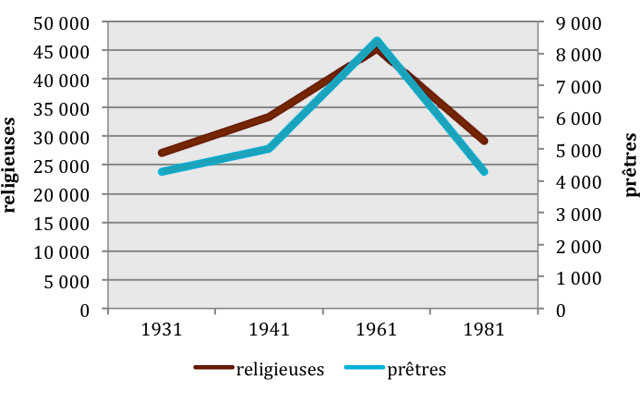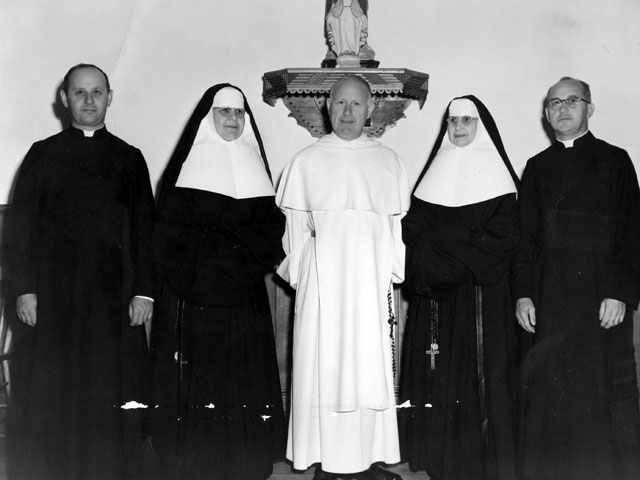Secondary Navigation Menu
Home > Events > Social Realities > The Decline of the Catholic Religion
The Decline of the Catholic Religion
An Omnipresent Religion
As of the mid 19th century, the Catholic religion exercised considerable influence in Quebec, to the point that historian Lucia Ferretti gave it the status of principal organizer of society in Quebec. Its hold was so great that French writer Paul Claudel referred to Quebec as the "Tibet of Catholicism." English Canadians referred to Quebec as the "priest-ridden province."
Crucifixes, Rosaries and Scapulars Forsaken
Designations fell quickly with the Quiet Revolution. Quebec became secularized within the space of a few years. The withdrawal affected not only the population, but Church representatives as well. Although on the rise throughout the 20th century, the number of priests and nuns dropped dramatically after 1961 owing to numerous departures (see Figure). Terms with religious connotations were secularized. Thus the Confédération des travailleurs catholiques du Canada (CTCC) became the Confédération des syndicats nationaux (CSN); the Corporation des instituteurs catholiques became the Centrale des enseignants du Québec (CEQ); the Sacré-Coeur and Dames de Sainte-Anne leagues became the Chrétiens d'aujourd'hui and the Mouvement des femmes chrétiennes, respectively. In the 1970s, the Union catholique des cultivateurs (UCC) became the Union des producteurs agricoles (UPA).
Number of Priests and Nuns in Quebec, 1931-1981

| Year | Nuns | Priests |
|---|---|---|
| 1931 | 27 000 | 24 000 |
| 1941 | 33 000 | 28 000 |
| 1961 | 45 000 | 46 000 |
| 1981 | 28 000 | 23 000 |
Sources: Lucia Ferretti, Brêve histoire de l'Église catholique au Québec, Montréal, Boréal, 1999, p. 116 ; Paul-André Linteau, René Durocher, Jean-Claude Robert and François Ricard, Histoire du Québec contemporain, Tome II : Le Québec depuis 1930, Montréal, 1989, p. 334 et 653.
Dwindling Church Attendance
At closer notice, the secularization process in Quebec and elsewhere in the world had already been underway for some time. In the 1950s, 40% of Quebecers no longer attended mass at their parish church on a regular basis. On the other hand, the number of priests and nuns increased until 1961. However, recruiting was becoming harder and harder. Another cause warranting consideration is the triumphalism demonstrated by the Church in Quebec during the first half of the 20th century. It was as if the Church were disconnected from the daily reality of people's lives. Finally, the radio and the more recent advent of television increasingly present in homes broadened people's horizons, airing new values not always compatible with those of the Church.
The Will to Adjust to a New Reality
Perfectly aware of the divide between itself and the faithful, the Church sought to revamp and renew its image. To this effect, Pope John XXIII introduced the Vatican II ecumenical council in 1962. A series of measures were set forth, among them the replacement of the Latin mass with masses in the language of the people, the distribution of communion by laymen, mass on Saturday evening and an end to the obligation of women to wear a hat in church, et al. The measures were welcomed wholeheartedly. However, such was not the case with the position of the Church on divorce in 1967 and contraception in 1968, which the Church vehemently condemned. This did nothing to draw the faithful back into the fold.
Related events
Related events
- The Creation of the Ministry of Education
- The Advent of the Welfare State
- The Advent of the Pill
- Epilogue




